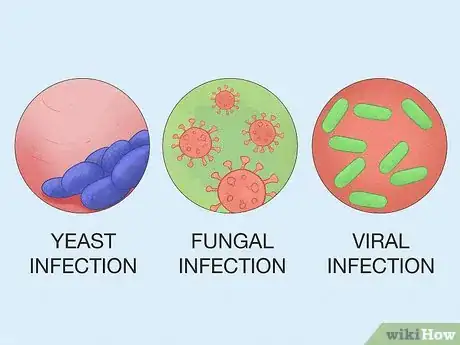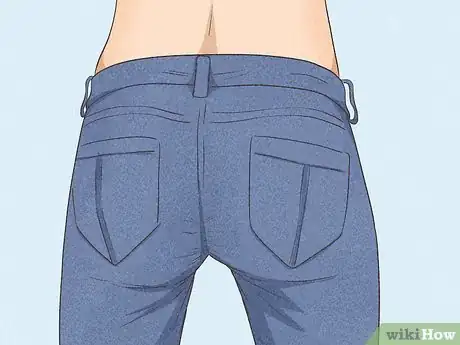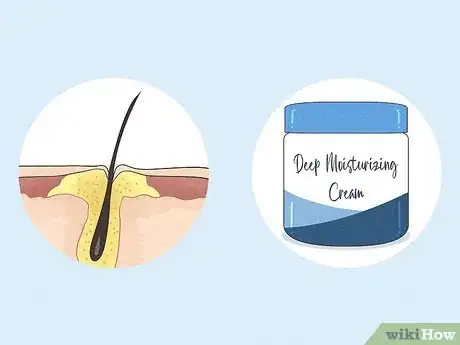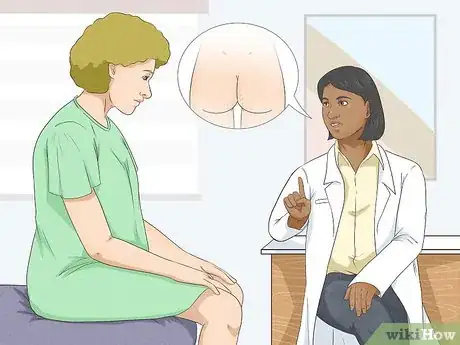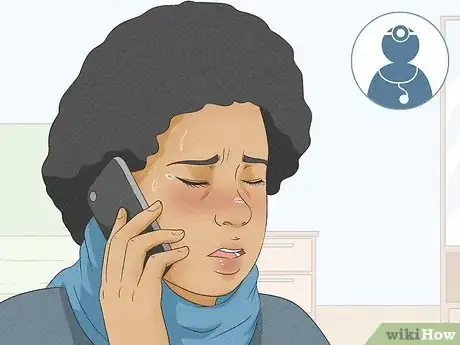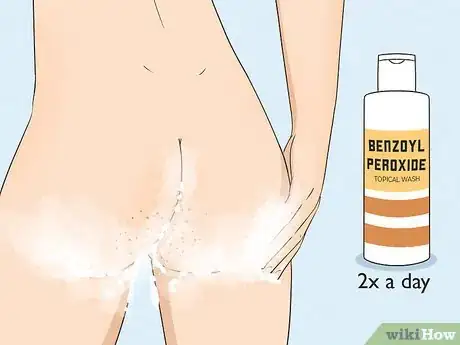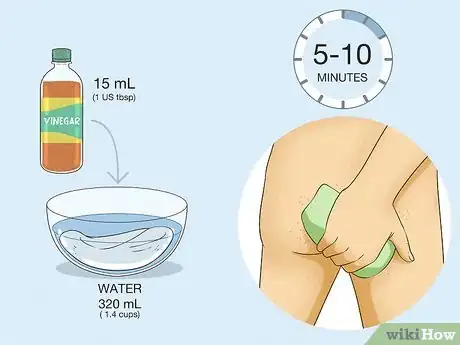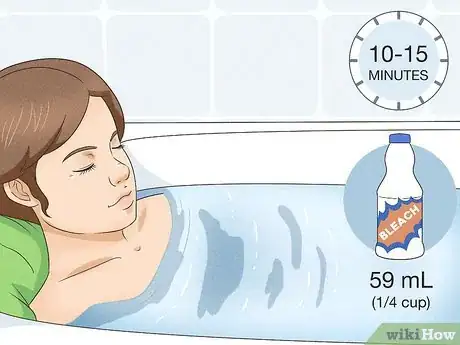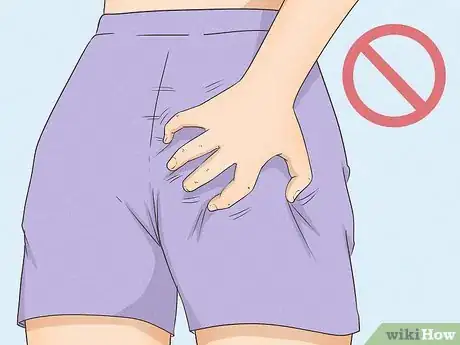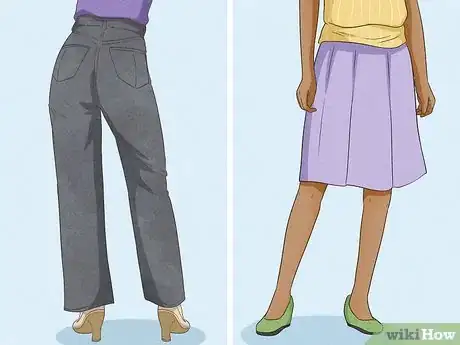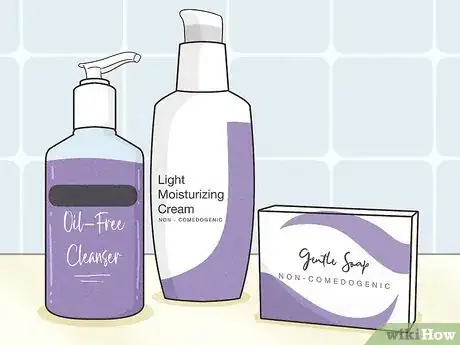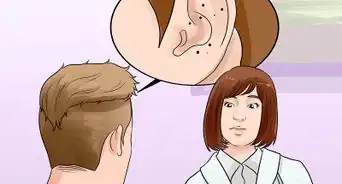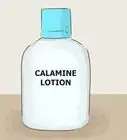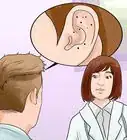This article was medically reviewed by Sarah Gehrke, RN, MS and by wikiHow staff writer, Janice Tieperman. Sarah Gehrke is a Registered Nurse and Licensed Massage Therapist in Texas. Sarah has over 10 years of experience teaching and practicing phlebotomy and intravenous (IV) therapy using physical, psychological, and emotional support. She received her Massage Therapist License from the Amarillo Massage Therapy Institute in 2008 and a M.S. in Nursing from the University of Phoenix in 2013.
There are 14 references cited in this article, which can be found at the bottom of the page.
wikiHow marks an article as reader-approved once it receives enough positive feedback. In this case, several readers have written to tell us that this article was helpful to them, earning it our reader-approved status.
This article has been viewed 2,425,968 times.
If you’ve noticed some uncomfortable red spots on your buttocks, you’re definitely not alone. Lots of people deal with this skin condition, but it may feel a bit strange or uncomfortable to bring up to a doctor or dermatologist. Don’t worry—this condition is perfectly normal and really easy to tackle at the source. Take a peek through some frequently asked questions and answers to get a little extra info!
Steps
What is causing my folliculitis?
-
1Your folliculitis might be caused by an infection. Many cases of folliculitis can actually be chalked up to a bacterial infection, which can look like a large boil. It may also be caused by a yeast, fungal, or viral infection—however, bacteria is the most common culprit when it comes to butt acne.[3]
-
2It might be caused by a lot of friction. If you wear really tight clothing, it might be chafing against your skin, which creates the “acne.” Take a look at some of your favorite shorts, pants, or other bottoms—if they’re pretty skin-tight, then they might be causing the issue.[4]
-
3Your hair follicles might be clogged. Your hair follicles might be blocked if you use a really creamy moisturizer or ointment for your skin. If you use a creamy moisturizer all over your skin, then that might be causing your folliculitis.[5]
- If you tend to sweat a lot, that may also be part of the problem.
Do I need to see a doctor or dermatologist?
-
1Visit a doctor or dermatologist if you think you have an infection. They can prescribe an antibiotic cream to help you tackle the bacteria at the source. Don’t worry—you shouldn’t have to take antibiotic pills for this unless your infection is really severe.[6]
- A doctor can confirm if it’s an infection, and if so, what’s causing it. If bacteria is causing the problem, then you’ll probably need antibiotic cream. However, fungal infections can be treated with over-the-counter creams and ointments.
-
2Call your doctor if you develop serious symptoms. Keep tabs on how you’re feeling—butt acne is typically harmless, but in more serious cases, folliculitis can lead to fever, nausea, chills, and more. If you’re feeling under the weather, call your doctor for guidance.[7]
How do I treat the breakouts?
-
1Clean the skin with a benzoyl peroxide wash. Pick up an acne wash with benzoyl peroxide as one of the main ingredients—this will kill off any bad bacteria in the area.[8] Dampen the skin with a wet towel, and massage the product onto the affected area. After 1-2 minutes, rinse off the product and pat the skin dry with a towel.[9]
- You can use this wash up to twice a day. Most people see results within 4 weeks, but it may depend on the case.
-
2Soak the area with a vinegar compress to ease the irritation. Mix 1.4 cups (320 mL) of water with 1 US tbsp (15 mL) of white vinegar. Dip a clean cloth in the mixture and sit on the compress for 5-10 minutes. You can make and use this compress up to 6 times each day.[10]
-
3Take a bleach bath twice a week if you have bacterial folliculitis. Fill your tub about halfway with warm water, and then stir in 1⁄4 c (59 mL) of bleach. Relax and unwind in the bath for 10 to 15 minutes, and then rinse yourself off with clean water.[11]
- This might stop the bacteria from returning again.
-
4Wait up to 2 weeks and see if it goes away. If your folliculitis is pretty mild, then it might clear up on its own. In some cases, it might go away within 7 to 10 days.[12]
How do I prevent future breakouts?
-
1Wear loose clothes instead of skin tight garments. Friction and folliculitis tend to go hand hand, and tight shorts and pants might be doing you more harm than good. Instead, rifle through your closet for pants, shorts, and other bottoms that fit comfortably, and don’t rub against your skin quite as much.[14]
-
2Take a shower with gentle soap right after you exercise. After a tough workout, bacteria may be trapped on your skin. Gently wash and rinse off the skin with a mild cleanser, so this bacteria doesn’t turn into folliculitis later on.[15]
- Always change out of your workout clothes right after you’ve exercised.[16]
-
3Ditch any oil-rich products from your beauty routine. Body oils tend to get bacteria stuck in your pores, which can lead to folliculitis. Instead, look for lotions, creams, and other skin products that aren’t as likely to clog up your follicles.[17]
- Look for products with “non-comedogenic” or “oil-free” on the label.[18]
Expert Q&A
Did you know you can get expert answers for this article?
Unlock expert answers by supporting wikiHow
-
QuestionHow much time does it take to heal this type of acne naturally?
 Sarah Gehrke, RN, MSSarah Gehrke is a Registered Nurse and Licensed Massage Therapist in Texas. Sarah has over 10 years of experience teaching and practicing phlebotomy and intravenous (IV) therapy using physical, psychological, and emotional support. She received her Massage Therapist License from the Amarillo Massage Therapy Institute in 2008 and a M.S. in Nursing from the University of Phoenix in 2013.
Sarah Gehrke, RN, MSSarah Gehrke is a Registered Nurse and Licensed Massage Therapist in Texas. Sarah has over 10 years of experience teaching and practicing phlebotomy and intravenous (IV) therapy using physical, psychological, and emotional support. She received her Massage Therapist License from the Amarillo Massage Therapy Institute in 2008 and a M.S. in Nursing from the University of Phoenix in 2013.
Registered Nurse
-
QuestionWhat happens if you have tried acne cream with Lactic Acid and it hasn't worked?
 Sarah Gehrke, RN, MSSarah Gehrke is a Registered Nurse and Licensed Massage Therapist in Texas. Sarah has over 10 years of experience teaching and practicing phlebotomy and intravenous (IV) therapy using physical, psychological, and emotional support. She received her Massage Therapist License from the Amarillo Massage Therapy Institute in 2008 and a M.S. in Nursing from the University of Phoenix in 2013.
Sarah Gehrke, RN, MSSarah Gehrke is a Registered Nurse and Licensed Massage Therapist in Texas. Sarah has over 10 years of experience teaching and practicing phlebotomy and intravenous (IV) therapy using physical, psychological, and emotional support. She received her Massage Therapist License from the Amarillo Massage Therapy Institute in 2008 and a M.S. in Nursing from the University of Phoenix in 2013.
Registered Nurse Be sure to follow a gentle cleansing routine. You can also try salicylic acid and benzoyl peroxide products. If you are not seeing an improvement in your acne after 2 to 4 weeks of using over-the-counter treatments, then you may need to talk to your healthcare provider about prescriptions that will help you get rid of the acne infection.
Be sure to follow a gentle cleansing routine. You can also try salicylic acid and benzoyl peroxide products. If you are not seeing an improvement in your acne after 2 to 4 weeks of using over-the-counter treatments, then you may need to talk to your healthcare provider about prescriptions that will help you get rid of the acne infection.
Warnings
- Only soak in a hot tub or heated pool if you know for sure that it’s clean. A dirty pool or hot tub might lead to folliculitis.[22]⧼thumbs_response⧽
- Avoid sharing razors. Razors can spread bacteria, so it’s not a great idea to share them with your friends and relatives. Instead, shave with your own personal razor, guiding it in the same direction your hair is growing.[23]⧼thumbs_response⧽
References
- ↑ https://www.seventeen.com/beauty/makeup-skincare/a15524144/butt-pimples/
- ↑ https://www.cosmopolitan.com/style-beauty/beauty/a13058571/butt-acne-zits/
- ↑ https://dermnetnz.org/topics/folliculitis/
- ↑ https://www.nationwidechildrens.org/conditions/folliculitis
- ↑ https://www.nationwidechildrens.org/conditions/folliculitis
- ↑ https://www.mayoclinic.org/diseases-conditions/folliculitis/diagnosis-treatment/drc-20361662
- ↑ https://uncw.edu/healthservices/documents/instructionsheet-folliculitis1012.pdf
- ↑ https://www.cosmopolitan.com/style-beauty/beauty/a13058571/butt-acne-zits/
- ↑ https://www.nhs.uk/medicines/benzoyl-peroxide/
- ↑ https://myhealth.alberta.ca/Health/aftercareinformation/pages/conditions.aspx?hwid=zc1589
- ↑ https://www.nationwidechildrens.org/conditions/folliculitis
- ↑ https://myhealth.alberta.ca/Health/pages/conditions.aspx?hwid=hw171614
- ↑ https://www.uofmhealth.org/health-library/hw171614
- ↑ https://www.mayoclinic.org/diseases-conditions/folliculitis/symptoms-causes/syc-20361634
- ↑ https://www.uofmhealth.org/health-library/hw171614
- ↑ https://www.aad.org/public/diseases/a-z/folliculitis
- ↑ https://www.healthdirect.gov.au/folliculitis
- ↑ https://www.aad.org/public/everyday-care/skin-care-secrets/face/treat-large-pores
- ↑ https://www.cosmopolitan.com/style-beauty/beauty/a13058571/butt-acne-zits/
- ↑ https://www.cosmopolitan.com/style-beauty/beauty/a13058571/butt-acne-zits/
- ↑ https://dermnetnz.org/topics/folliculitis/
- ↑ https://www.mayoclinic.org/diseases-conditions/folliculitis/symptoms-causes/syc-20361634
- ↑ https://uncw.edu/healthservices/documents/instructionsheet-folliculitis1012.pdf
About This Article
To get rid of acne on your buttocks, wash your buns in the morning and at night with a gentle soap or body wash to remove excess oils. After you've rinsed, apply an acne lotion, like Clearasil or Proactive, to the affected area. You can also try doing a natural acid rinse by diluting some apple cider vinegar or lemon juice with water and spraying it on your buttocks. Let it sit for 5-10 minutes and then rinse well to avoid over-drying your skin. If you have painful or chronic buttock pimples, visit your doctor to see if a steroid treatment or antibiotic might help. For tips from our Nurse reviewer on how to reduce painful inflammation, read on!


